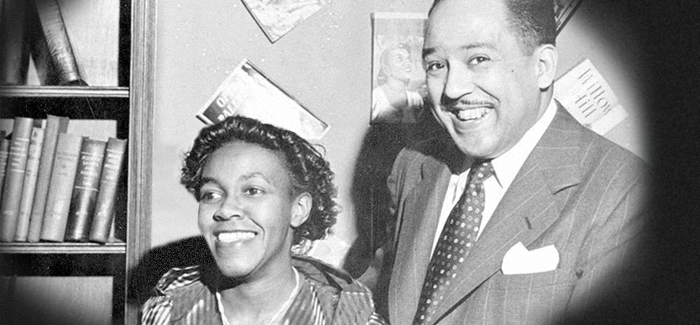
Hughes, shown with Gwendolyn Brooks, enjoyed his stint at Lab. (Photo courtesy Yale Collection of American Literature, Beinecke Rare Book and Manuscript Library)
Langston Hughes made a lasting impression as a visiting lecturer at the Laboratory Schools.
In 1949, just six years after the University of Chicago Laboratory Schools admitted its first African American students, Langston Hughes spent eight weeks there as a visiting lecturer on poetry. The Harlem-based writer—well known at 47—had read his poetry to children but never taught them before.
The neatly typed 14-page report that Hughes submitted at the end of his stay, now housed with his papers at Yale, reveals his enthusiasm for the assignment. At Lab he offered weekly creative writing workshops for students in grades six to ten, and seminars on jazz and the “negro theme” in American poetry. He helped small children compose stories and practice rhymes and expressed regret that his schedule was too packed to visit the kindergarten regularly.
“Writing may have, I believe, for some adolescents a psycho-therapeutic value,” Hughes wrote in his report. Nearly 70 students attended workshops—with “no compulsion, no grades”—and turned in manuscripts for Hughes to review. He praised Lab students generally as having “more initiative, freedom of expression, and independence of thought than any I have known before.” Even the youngest children, he noted, asked interesting questions.
Why would a writer of national stature set aside his own professional projects to teach school in Chicago? In The Life of Langston Hughes, biographer Arnold Rampersad provides some clues. Hughes’s left-leaning politics sparked accusations that he was a Communist and attracted negative attention to his 1947 speaking tour. The Chicago Tribune called him a “red-tinged poet,” and he was denounced on the Senate floor as pro-Russian in 1948. Hughes struggled to find publishers for a poetry anthology and for Simple Speaks His Mind, a book adapted from popular columns he’d written for the Chicago Defender, ultimately released by Simon and Schuster in 1950.
Around that time, Lab’s director, Warren Seyfert, had shared a Thanksgiving dinner with Hughes at which the poet thoroughly charmed Seyfert’s three young daughters. He offered Hughes a $2,000 stipend to spend spring quarter as poet in residence, in a year when his total income was $8,800. “The school certainly got its money’s worth,” a teacher recalled. Hughes offered sessions on poetry recitation, helped with a school musical program, and talked to a geography class about his travels in Mexico. “The fact that he was a black instructor among children almost all of whom were white seemed not to matter,” writes Rampersad. “Loving children, and eager to please, he made friends easily.”
Hughes lived modestly in a seventh-floor room at International House just down 59th Street from the school. After hours he liked to visit Lab art teacher Robert Erickson, who had a giant jazz and blues record collection, and his wife in their attic apartment at 5611 South Blackstone. He appeared with local poet Gwendolyn Brooks at a South Side public library branch, and she came to Lab to speak to his high school students. Just before Hughes left town, Brooks packed close to 100 people into her two-room apartment on East 63rd Street for his farewell party.
Although Hughes received offers, he never accepted a teaching appointment again. He expressed a few minor complaints in his report to Lab. The school’s cramped auditorium couldn’t seat everyone who wanted to hear Brooks; eight weeks wasn’t enough to help students become better writers; teaching left him little time for creative work. The poet liked to sleep late and Rampersad quotes him as finding early morning classes to be “too much for me at my advanced age.” As a pupil, Hughes wrote, he was never on time for school: “I see no need to start straining my ego now just to improve race relations.”
